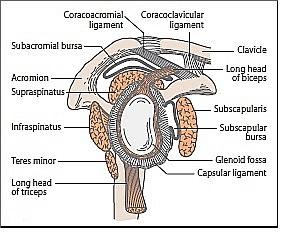The rotator cuff is the sheath of conjoint tendons which run over the top of the shoulder capsule and inserts into the greater tuberosity of the humerus
- the tendons are those of the short muscles of the shoulder - supraspinatus, infraspinatus, teres minor and subscapularis
- the cuff is covered anteriorly by the coracoacromial arch with the subacromial bursa in between
- the main role of the cuff is to stabilise the humeral head within the glenoid, particularly when the arm is flexed or abducted by the deltoid muscle

Muscle | Origin on scapula | Attachment on humerus | Function | Innervation |
subscapularis muscle | subscapular fossa | lesser tuberosity (60%) or humeral neck (40%) | internally rotates the humerus | subscapular nerve (C5-6) |
supraspinatus muscle | supraspinous fossa | inserts on the middle facet of the greater tuberosity | abduction of the arm | suprascapular nerve (C5) |
infraspinatus muscle | infraspinous fossa | inserts posterior facet of theon the greater tuberosity | externally rotates the arm | suprascapular nerve (C5-6) |
teres minor muscle | middle half of the lateral border | inserts on the inferior facet of the greater tuberosity | externally rotates the arm | axillary nerve (C5) |
The subacromial space lies underneath the acromion, the coracoid process, the acromioclavicular joint and the coracoacromial ligament. A bursa in the subacromial space provides lubrication for the rotator cuff
Supraspinatus is the cuff tendon most liable to injury. It is the most exposed of the tendons - running over the top of the shoulder under the anterior edge of the acromion and the adjacent acromioclavicular joint - and also has a relatively poor arterial blood supply near to it's insertion into the greater tuberosity. Consequently, `supraspinatus' is often used synonymously with `rotator cuff' when describing lesions of this area.
- the rotator cuff is the dynamic stabilizer of the glenohumeral joint
- the static stabilizers are the capsule and the labrum complex, including the glenohumeral ligaments
- although the rotator cuff muscles generate torque, they also depress the humeral head
- the deltoid abducts the shoulder
- without an intact rotator cuff, particularly during the first 60 degrees of humeral elevation, the unopposed deltoid would cause cephalad migration of the humeral head, with resulting subacromial impingement of the rotator cuff
- in patients with large rotator cuff tears, the humeral head is poorly depressed and can migrate cephalad during active elevation of the arm. This migration is sometimes evident even on plain radiographs
- the space between the undersurface of the acromion and the superior aspect of the humeral head is called the impingement interval
- this space is normally narrow and is maximally narrow when the arm is abducted. Any condition that further narrows this space can cause impingement
The main disorders of the rotator cuff are:
- rotator cuff syndrome
- acute calcific tendinitis
- adhesive capsulitis
Rarely, the infraspinatus may be affected alone.
The clinical features of these disorders may overlap yet they represent distinct pathologies.
Related pages
Create an account to add page annotations
Annotations allow you to add information to this page that would be handy to have on hand during a consultation. E.g. a website or number. This information will always show when you visit this page.